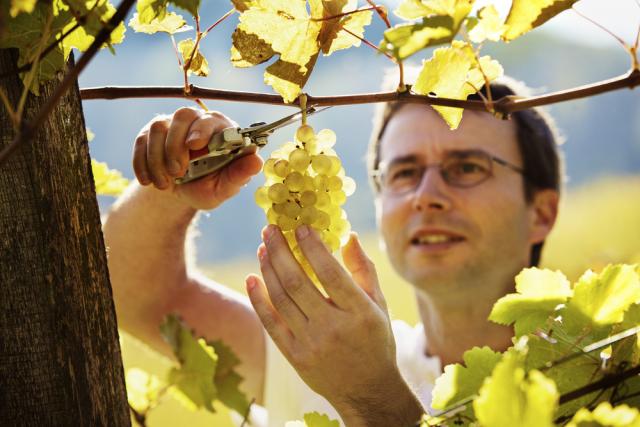Our family has been making home wine in one way or another for 50 years. Since retiring in 2000, we’ve had the pleasure of growing grapes and making wine on our 10 acre spread here in the Finger Lakes, including a few medals along the way. I was disabled from a stroke on Fathers Day in June of 2000, working in the gardens and making wine has kept me active. I was a web development engineer for Kodak before the stroke. I registered a domain & put up a site, just in case our son ever wanted to move back to this area and make it a commercial venture. Our info is at www.skaneatelesvineyards.com At 67, I’m too old for doing anything but home gardening and volunteering at the local Cornell Extension. Right now we have about 100 vines along with plenty of other fruits and vegetables to care for. In the winter I do some programming to pass the time along with tending to the wine in progress and enjoying a few glasses. Every year we give away about 200 bottles of wine to family and friends at Christmas. So many people look forward to getting jelly & wine at Christmas that we’ve had to cut back to 375 ml splits to make it go further. We have one more goal, to get a gold medal from the winemaker magazine international competition. Then we will just enjoy the fruits of our winemaking and gardens as we grow older.
Feel free to take any pictures from our site and info from this local newspaper story.
Name: Bill Aaron
State: New York
Wine Making Set-Up
I built my own wine press.
I grow muscadine grapes.
I find peach wine the least expensive and less work.
I find ways to process mango wine when the fruit is free to me.
Name: Charles C. Applegate
State: Florida
wine making
Mine is made in a 5 gallon bucket with a lid and a small hole for a plastic tube to go into a glass of water. We use 20 pounds of fruit and 10 pounds of sugar and 2 table spoons of dry yeast cooked over the stove to 110 degrees and fill bucket with water within 2 inches from top add fruit, sugar, yeast, put lid on and let set for 6 weeks, then strain over cheese cloth, then add water and sugar if needed. Then let set for 6 weeks and should be ready to bottle.
Name: Donald Eastman
State: IOWA
What Set up?
Hi. My name is Bryan and my 1st vintage was 2005. I have a source for Zinfandel in the Paso Robles area of the California Central Coast. I help the vineyard owner hand harvest his 2 acres and he lets me take a few hundred pounds. My operation is located in my garage and guest bathroom. I hand crush, with a rubbermade container and a 2×4. Ferment in a 40 gallon trash container and press by hand with a fruit bag, a milk crate and a barbell weight. Age in 5 gallon carboys with oak staves and bottle one at a time from a 5 gallon bucket with a spigot. Hand cork with floor corker, use a tea kettle to steam capsules, print labels on computer and atttach with glue. It takes me about 6 hours to crush nad another 2 or so to press. Truely handmade wine but it comes out great.
Name: Bryan Bell
State: California
Tell Us Your Wine Making Story!
 Do you have a wine operation that you are proud to show off?
Do you have a wine operation that you are proud to show off?
If so, we’d love to hear from you! Simply submit a picture of your wine setup and tell us a bit about it (i.e. What is your favorite wine to make? What pieces make up your operation? What makes you/your setup unique?). We will also feature your submission on our blog where you can share it with your family and friends!
We can’t wait to hear from you, so upload a picture and tell us about your wine making operation now!
Thank You

What's Your Wine Making Story?

We’d love to learn more about your wine making adventures. You can tell us about your wine making set-up. The best wine you ever made. Why you like to make wine. Or whatever other wine making tale you’d like to tell. We’re just bubbling over with curiosity!
My Fermentation Has Too Much Sugar. What Should I Do?
 Oh OH, Mr.” wineproblemsolver”,I have a stuck ferment in my wild grape wine at 1.012. I tried adding a fresh yeast culture and yeast nutrient and it has not responded. My guess is I had the sugar to high. I was reading about 1.090 at the start but realized there was undissolved sugar in the bottom of the fermenter. I am not sure how much. The fermentation went well to SG 1.015 and then stalled. It went slowly down to 1.012 after the addition of the new culture then stuck tight. I might have a high alcohol problem? What do you think. Can I get it going again with a high tolerant alcohol yeast? What do you recommend? Dr. P
Oh OH, Mr.” wineproblemsolver”,I have a stuck ferment in my wild grape wine at 1.012. I tried adding a fresh yeast culture and yeast nutrient and it has not responded. My guess is I had the sugar to high. I was reading about 1.090 at the start but realized there was undissolved sugar in the bottom of the fermenter. I am not sure how much. The fermentation went well to SG 1.015 and then stalled. It went slowly down to 1.012 after the addition of the new culture then stuck tight. I might have a high alcohol problem? What do you think. Can I get it going again with a high tolerant alcohol yeast? What do you recommend? Dr. P—–
Hello Dr. P,
———————————————————————————————————
Ed Kraus is a 3rd generation home brewer/winemaker and has been an owner of E. C. Kraus since 1999. He has been helping individuals make better wine and beer for over 25 years.
Ten Facts You May Not Know About Winemaking
The history of wine production dates back to 6,500 years ago, where archeological evidence has been cited in various sites in Europe. Since the first days of wine production, wine has continued to play an integral role in the history of culture, civilization, cuisine, and agriculture. The United States alone has nearly 3,000 vineyards, clearly depicting the continual high demand for this product. As wine continues to be an integral aspect of culture, personal winemaking is also becoming a popular pastime and hobby. Wine making kits and supplies make creating personal wines a simple process and an enjoyable hobby that can be shared with friends and family. Wine making also presents a myriad of options that might not necessarily be available with store bought wines, and allows you to customize the drink to your liking. Creating homemade wines allows for adjustments in sweetness, heaviness, and alcohol content. Additionally, there are endless recipes and opportunities for new types of homemade wine, allowing for varying wine making experiences and flavors. To get started, make sure to check out our Adventures in Homebrewing recipe guide and Wine Making FAQ.
We decided to share with you the ten top facts about making wine at home that you may not have known.
1. One in every five bottles of wine are personally made at home with wine making equipment.
2. Homemade wine is approximately a third of the cost of store bought wine. Over time, a home wine making kit will pay for itself.
3. You can produce up to 30 bottles of homemade wine in as little as four weeks with the correct wine making supplies.
4. Wine making equipment does not require a large space, and can easily be used in smaller kitchens.
5. Wine making also is not time consuming. The entire process totals a mere 4-5 hours, spread over the period of one month.
6. Many wines are made from grapes, but wine making allows for the option to choose from various fruit types or juice concentrates to create new flavors.
7. You can easily grow your own grapes and fruit to further customize the overall wine making process.
8. Wine making additionally allows you to customize wine to your liking, and choose from a variety of preferences such as sweet vs. sour, light or heavy, and alcohol content.
9. Wine making kits are easy to acquire and Adventures in Homebrewing offers a variety of wine making supplies at varying price points to suit your wine making needs.
10. Each wine making kit comes with a how-to guide which guides you simply through the wine making process.
For more information on wine making and how to get started with the process, be sure to check out our informative resources and wine making guides on Homebrewing.org.
4 Things You May Not Know About Making Your Own Wine and Beer
There are some things that are just easier to buy instead of making yourself. Just like mattresses – apparently, no one has ever tried to make a mattress on their own. And then there are some things that people buy instead of making because they don’t know how to do it or don’t know if it would be worth doing.
Beer and wine are things that can be made at home and it’s surprisingly simple. Here are some things you may not know about it.
1) It’s not as hard as you think
Making wine or beer is a science. Getting everything just right – removing grittiness, maintaining flavor and freshness, etc. – can be a complicated process. But that doesn’t mean it’s an especially difficult process.
Anyone with the proper home beer brewing or wine making equipment can make their own. Adventures in Homebrewing sells wine and beer making kits with complete instructions for the novice home brewer.
2) It’s legal
The thought of making your own beer or wine may conjure up images of backwoodsmen moonshiners hiding from the law; cranking out bottles of white lightning from stills secreted away in the hills. Or perhaps, the Baldwin sisters from TV’s The Waltons who made a very alcoholic and very illegal concoction that they called “the recipe.”
While it is illegal to make your own whiskey or moonshine, making your own wine or brewing your own beer is perfectly legal. There are however certain restrictions. Homemade beer and wine is for “personal” consumption so you can’t sell it. Also, you can only make a certain amount of it – 100 gallons a year per adult in a household.
3) It’s not as expensive as you think
When the CD player first came out, it was very expensive. Only the richest of kings of England could afford it. Okay, that’s an exaggeration, but you understand. It was expensive, but, with time, the technology became cheaper. This is true with wine and beer making supplies, too. While once costly, it is now relatively inexpensive.
Also, in the past, bulky and pricey fruit presses or crushers were needed to make wine. Now concentrates or juices can be used instead.
4) It can be just as good as or better than commercial wines and beers
The commercial beer and wine makers have a variety of tastes and products, but you’re still limited to that specific group of tastes and products. Making wine at home or homebrewing beer gives you more options. And since you’re making it yourself, you can customize it to fit your tastes exactly. You can’t do that with the commercial stuff.
The quality of what you make can be as good as anything found in the stores. Adventures in Homebrewing has sold quality winemaking and beer-making supplies since 1966 and has had customers returning for over 40 years.
